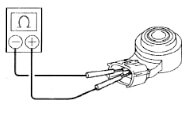Toyota Camry P0328
Toyota Camry P0328 diagnose and fix
A Toyota Camry P0328 trouble code is defined as Knock Sensor Range Check (High voltage). A Toyota Camry P0327 code is defined as Knock Sensor Range Check (Low voltage).
The knock sensor contains a piezoelectric element that generates a voltage when it becomes deformed. The voltage is generated when the engine block vibrates due to knocking. The ECM then retards engine spark timing to maximum retard to reduce knock.
The monitor for DTCs P0327 and P0328 begins to run when 5 seconds have elapsed since the engine was started. If the output voltage transmitted by the knock sensor remains low or high for more than 1 second, the ECM interprets this as a malfunction in the sensor circuit and sets a DTC.
In a Toyota Camry P0328 situation, the ECM is seeing more than 4.5-volts on the knock sensor circuit. Possible causes of the high voltage are:
In a Toyota Camry P0327 situation, the ECM is seeing less than 0.5-volts on the knock sensor circuit. Possible causes of the high voltage are:
• Rodent chewing through knock sensor wiring harness
• Open in the knock sensor circuit
• Bad knock sensor
• Bad connection to ECM
• Or, bad gas, wonky fuel injector—anything that’s actually causing a knock or misfire.
Most common cause of Toyota Camry P0328
Rodent damage on the wiring harness. The knock sensor is installed under the intake manifold. That areas provides a warm sheltered area that rodents like. Worse yet, rodents like to chew on the newer soy-based wiring insulation, making for the worst possible situation.
Step 1 Check for signs of rodents
If you see nesting material under the intake manifold, suspect wiring damage.
Step 2 Review your conditions prior to the P0328
Was it raining? Sensor connections can get wet
Did you just fill with gas? Gas may be contaminated with water causing misfire and knock
Step 3 Check for leaking water pump
Coolant can leak onto the crankshaft sensor causing misfire which is seen by knock sensor.
Check knock sensor resistance

Using an ohmmeter, measure the resistance between the terminals. Standard resistance: 120 to 280K Ω at 20°C (68°F). If the resistance is not specified, replace the sensor.
Knock sensor torque is critical
a. Install the knock sensor with the nut. Torque: 20 N*m (204 kgf*cm, 15 ft.*lbf)
©, 2020 Rick Muscoplat
Posted on by Rick Muscoplat
